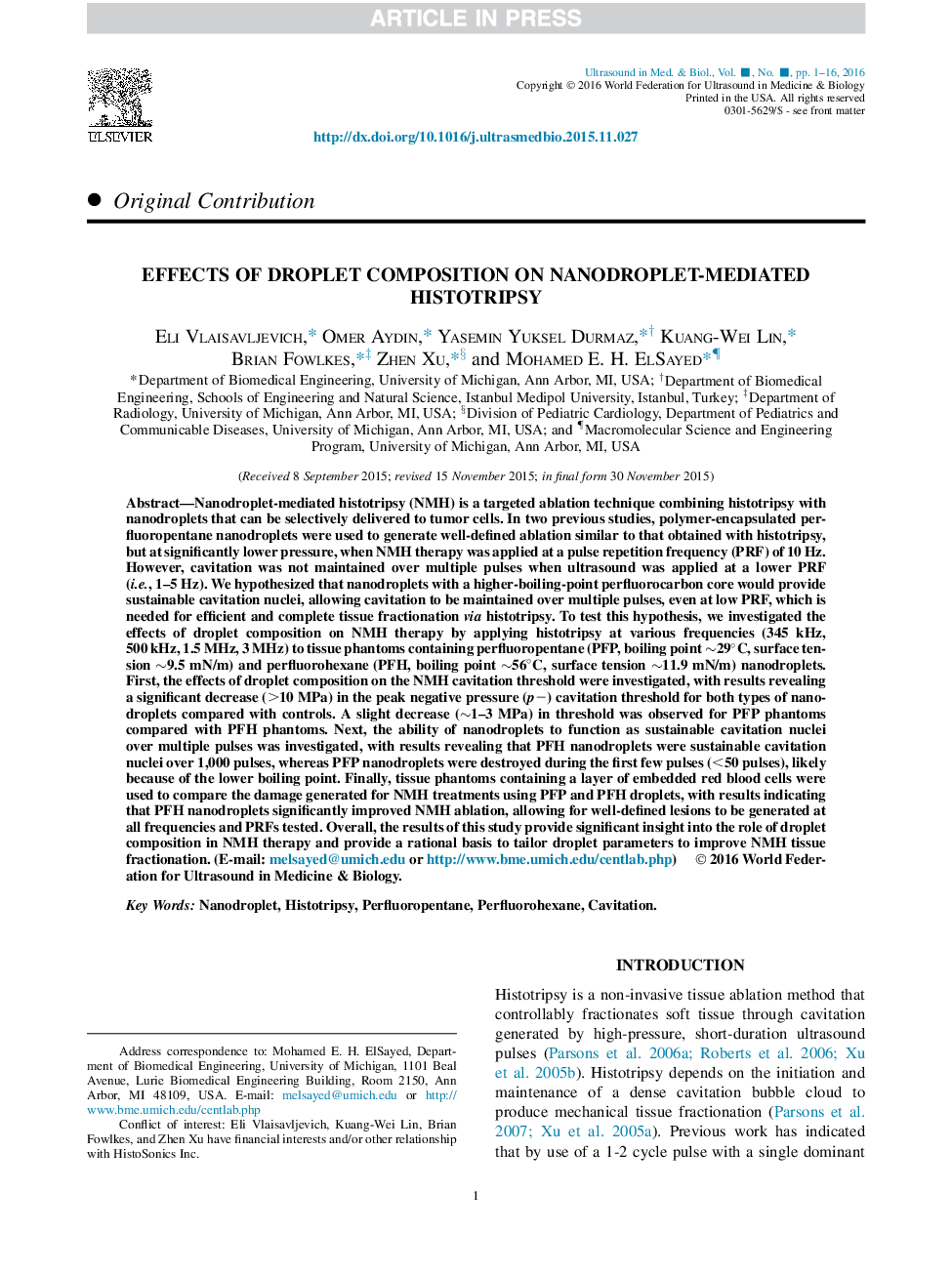| کد مقاله | کد نشریه | سال انتشار | مقاله انگلیسی | نسخه تمام متن |
|---|---|---|---|---|
| 1760242 | 1019581 | 2016 | 16 صفحه PDF | دانلود رایگان |
عنوان انگلیسی مقاله ISI
Effects of Droplet Composition on Nanodroplet-Mediated Histotripsy
دانلود مقاله + سفارش ترجمه
دانلود مقاله ISI انگلیسی
رایگان برای ایرانیان
کلمات کلیدی
موضوعات مرتبط
مهندسی و علوم پایه
فیزیک و نجوم
آکوستیک و فرا صوت
پیش نمایش صفحه اول مقاله

چکیده انگلیسی
Nanodroplet-mediated histotripsy (NMH) is a targeted ablation technique combining histotripsy with nanodroplets that can be selectively delivered to tumor cells. In two previous studies, polymer-encapsulated perfluoropentane nanodroplets were used to generate well-defined ablation similar to that obtained with histotripsy, but at significantly lower pressure, when NMH therapy was applied at a pulse repetition frequency (PRF) of 10 Hz. However, cavitation was not maintained over multiple pulses when ultrasound was applied at a lower PRF (i.e., 1-5 Hz). We hypothesized that nanodroplets with a higher-boiling-point perfluorocarbon core would provide sustainable cavitation nuclei, allowing cavitation to be maintained over multiple pulses, even at low PRF, which is needed for efficient and complete tissue fractionation via histotripsy. To test this hypothesis, we investigated the effects of droplet composition on NMH therapy by applying histotripsy at various frequencies (345 kHz, 500 kHz, 1.5 MHz, 3 MHz) to tissue phantoms containing perfluoropentane (PFP, boiling point â¼29°C, surface tension â¼9.5 mN/m) and perfluorohexane (PFH, boiling point â¼56°C, surface tension â¼11.9 mN/m) nanodroplets. First, the effects of droplet composition on the NMH cavitation threshold were investigated, with results revealing a significant decrease (>10 MPa) in the peak negative pressure (pâ) cavitation threshold for both types of nanodroplets compared with controls. A slight decrease (â¼1-3 MPa) in threshold was observed for PFP phantoms compared with PFH phantoms. Next, the ability of nanodroplets to function as sustainable cavitation nuclei over multiple pulses was investigated, with results revealing that PFH nanodroplets were sustainable cavitation nuclei over 1,000 pulses, whereas PFP nanodroplets were destroyed during the first few pulses (<50 pulses), likely because of the lower boiling point. Finally, tissue phantoms containing a layer of embedded red blood cells were used to compare the damage generated for NMH treatments using PFP and PFH droplets, with results indicating that PFH nanodroplets significantly improved NMH ablation, allowing for well-defined lesions to be generated at all frequencies and PRFs tested. Overall, the results of this study provide significant insight into the role of droplet composition in NMH therapy and provide a rational basis to tailor droplet parameters to improve NMH tissue fractionation.
ناشر
Database: Elsevier - ScienceDirect (ساینس دایرکت)
Journal: Ultrasound in Medicine & Biology - Volume 42, Issue 4, April 2016, Pages 931-946
Journal: Ultrasound in Medicine & Biology - Volume 42, Issue 4, April 2016, Pages 931-946
نویسندگان
Eli Vlaisavljevich, Omer Aydin, Yasemin Yuksel Durmaz, Kuang-Wei Lin, Brian Fowlkes, Zhen Xu, Mohamed E.H. ElSayed,